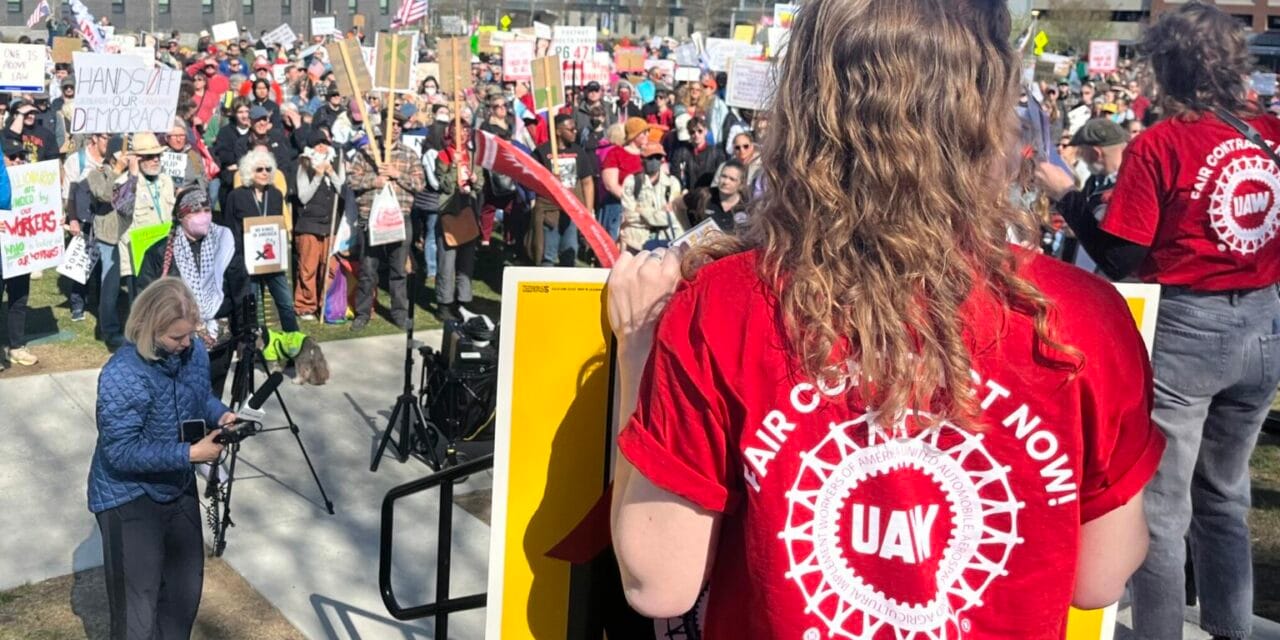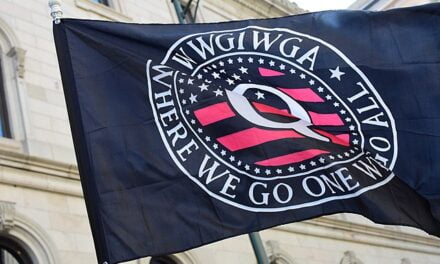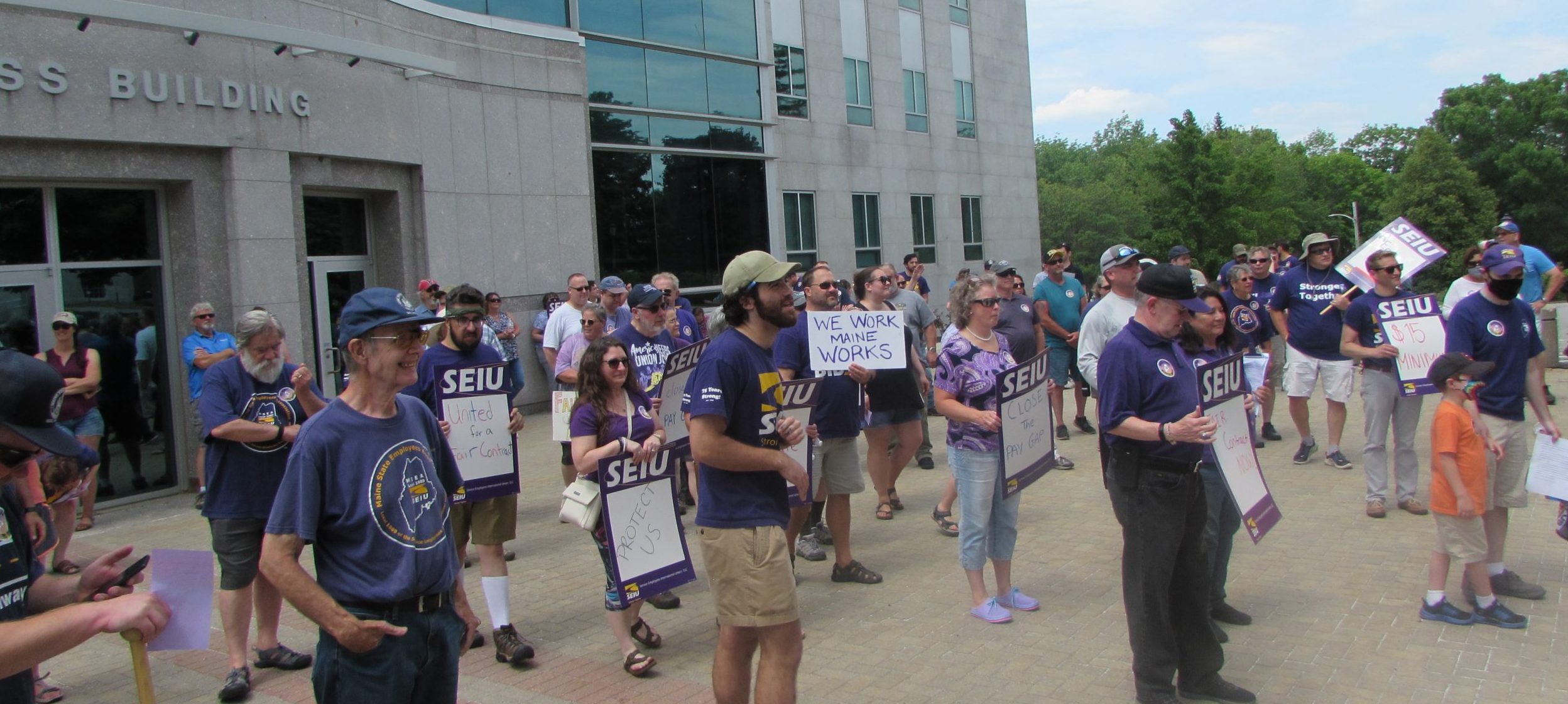This article is reprinted from the Socialist Forum, a publication of DSA. It was authored by Todd Chretien, who serves both on DSA’s Editorial Board as well as Pine & Roses’ Editorial Collective. It was originally published on May 30, 2025.
What happened?
Hundreds of thousands of workers marched and rallied on May Day, making it the largest International Workers Day since 2006 when two million immigrant workers left work and marched to demand their rights. Protests were organized in 1300 locations, large and small; no doubt the first May Day protest in many places. Broadly speaking, there were three different levels of mobilization. First, as in 2006, Chicago stood out with some 30,000 marching, organized by a mass coalition of labor and immigrant rights organizations. Second, cities like Philly, New York, Baltimore, San Francisco, Oakland, Burlington, and Portland, Maine mobilized between two and fifteen thousand. Third, hundreds of cities and towns turned out crowds from a couple dozen to hundreds, including smaller cities like Davis, California. This ranking is not intended as a judgement on the organizers. In fact, some of the smaller rallies included higher percentages of the population than the largest. For instance, in the town of Wayne, Maine—population 1,000—seventy-five people turned out for both morning and evening rallies.
It’s worth noting that the crowds were not as large as the April 5 day of protest initiated by Indivisible; however, participants were noticeably more multiracial, younger, and radical with widespread support for transgender rights and opposition to the genocide of Palestinians in Gaza. Though an important step in the process of building working-class unity against the billionaires and capitalist class, these efforts have a long way to go. For instance, although multiracial, at the national level, the marches did not entirely reflect working-class diversity. And if immigrant rights organizations were critical in many cities, Trump’s reign of terror against immigrant workers suppressed turnout from this community in many places.
Who organized it and how?
Memory and sacrifice play a role in sustaining oppositional working-class culture. No Haymarket Martyrs, no May Day. More recently, the 2006 May Day protests provided a living link to the past as well as the importance of International Workers Day globally. UAW president Shawn Fain’s call for unions to align contracts and lead a 2028 general strike, have introduced May Day to a whole new generation of labor organizers.
Recently, precursor actions in the wake of Trump’s election laid the basis for pulling together a mass, class-based response. As the saying goes, the best organizing tool is a bad boss and Trump is one of the worst bosses possible. Repression and widespread layoffs do not always provoke resistance, but this time targeted workers put up a critical mass of opposition that gummed up the works and provided the time to organize a strategic response.
Thousands of teachers from across the country responded to a call by the National Education Association and the American Federation of Teachers for walk-ins in March to protest Trump’s destruction of the Department of Education. Bay Area activists organized a “Day of Resistance” against ICE even before Trump was inaugurated. The Maine State Nurses Association led a rally to protest Medicaid cuts in March and organized a mass town hall to prevent the closure of the obstetrics department in the small town of Houlton. Kathryn Lybarger, president of AFSCME 3299 representing 22,000 workers at the University of California, summarizes her union’s approach, “My union went on its fourth strike in six months on May Day, and the energy felt great. For union members fighting a powerful employer for our families’ futures, it was amazing to be joined on the picket line by all kinds of community members who are fighting billionaires for their futures too. The day felt like an event and an important step in building the movement we need to stop Trump and win a better world.” In the single biggest display of working-class power on May Day, 55,000 LA County employees in SEIU 721 walked off the job and marched through downtown LA.
As federal workers reeled from Trump’s layoffs, the Federal Unionist Network was one of the most important elements blunting the blitzkrieg. FUN organizer Chris Dols explains, “Amidst all the necessary defense we’re playing against the billionaires’ offensive, May Day is the labor movement’s opportunity to articulate a positive vision for the world we deserve. Federal workers are uniquely positioned and proud to help advance such a vision because, above all else, we are public servants, and it is the entire public that is under assault. As is captured by the FUN’s ‘Save Our Services’ demand, our approach to May Day was to foreground the crucial services and protections federal workers provide in an effort to not only cohere fighting federal labor movement but also to develop and deepen alliances with all who stand to lose the most if Trump gets away with smashing up our agencies.”
Pair these factors with decades of bipartisan misery inflicted on the working class, and it’s not surprising workers are angry. Politicians have failed to deliver on demands like healthcare for all, affordable housing, and a stronger public education system. Add inflation, union-busting, white supremacy, misogyny, transphobia and homophobia, genocide in Gaza, and anti-immigrant bigotry, and the potential for uniting large parts of the working class across its many divisions comes into focus.
Chicago takes the lead
Yet objective conditions alone cannot make a plan. Organized forces with the credibility and capacity to think through a strategy and to put it into practice are needed.
According to Jesse Sharkey, past president of the Chicago Teachers Union and lead organizer with the newly-formed May Day Strong coalition, “Chicago became a center of May Day organizing this year for two reasons—first, there was a local coalition that got a lot of people involved. Activists from the immigrants rights community were extremely important in initiating it, and they held open meetings. They invited anyone who wanted to help organize. That drew in trade unionists, and many others. On a second front, Chicago was in the middle of initiating a national call for May Day protests… The call for that effort came from the Chicago Teachers Union and a handful of allied organizations such as Midwest Academy, Bargaining for the Common Good, and the Action Center on Race and the Economy. The NEA also played an extremely helpful role. In late March, we had about 220 people from over 100 organizations join us in Chicago to start planning for May 1 actions. The reason we were able to initiate such a widespread effort was because we have a past practice of closely linking trade union fights to wider working-class demands. In places where local unions have worked with community and activist groups, we had networks of communication and trust. Then, once that effort had reached a certain critical mass, some of the big national networks like Indivisible and 50501 got on board, and that really grew the reach of the day.”
It’s not that the CTU and immigrant community organizers in Chicago were the only ones thinking about May Day, but their action drew together and amplified similar efforts across the country, nationalizing the protest by providing a framework and resources for labor and community organizers in hundreds of towns and cities. Chicago didn’t create May Day 2025—thousands of activists across the country had to take up the call—but it did open a door.
Socialists and the united front
Assessing the impact of May Day for the working class as a whole should not be conflated with DSA’s role in the organizing. But as this is an article that will mostly reach DSA members, it’s worth reviewing what we contributed. First, thousands of DSA members across the country turned out for May Day. This fact alone shows our organization’s strength, and it points to opportunities and responsibilities. If all your chapter was able to do was to turn out members or help publicize the local protest among coworkers and the broader community, that’s an important contribution. Second, at the National Level, DSA’s National Political Committee and National Labor Commission joined May Day Strong and organized membership Zoom meetings to encourage branches to take action starting in March. Third, and this should come as no surprise, DSA played a bigger role in some places than others. I think it’s worth considering the impact of the strategic and tactical choices local chapters made on the influence they wielded and the organic ties they deepened. After speaking with comrades from across the country, I will offer a few positive examples. I hope comrades will add to this picture and offer alternative ideas or criticisms.
New York
In October, the NYC-DSA chapter adopted a resolution to support the UAW’s call for a 2028 May Day strike. The chapter subsequently held an internal May Day 2028 strategy retreat and identified May Day 2025 as a key link in the chain of developing power and political momentum to fight against Trump and the broader machine. As one DSA organizer puts it, “It’s not enough to circle May Day 2028 on a calendar, we need to build a coalition to organize it and politicize it.” Rooted in this perspective, NYC-DSA turned out to support a mass post-election labor-left anti-Trump rally, the FUN day of action in February, the subsequent Stop the Cuts rally on March 15, and Hands Off on April 5.
Olivia Gonzalez Killingsworth, co-chair of NYC-DSA Labor Working Group and National Labor Commission SC member (as well as a twenty-year member of Actors’ Equity Association and SAG-AFTRA) picks up the story, reflecting, “After Stop the Cuts, I went to Chicago on March 19 and 20 as an NLC representative to join the May Day Strong meeting. Stacy Davis Gates, Jackson Potter, and Jesse Sharkey welcomed us all into the house that CTU built. Shawn Fain was there along with Randi Weingarten, who was enraged because Trump signed his executive order gutting the Department of Education that same day. We broke out into regions and were charged with going back home to build May Day as big as possible. In New York City, broadly speaking, there were three important currents: the core of the union movement represented by the Central Labor Council, the left-liberals like Tesla Takedown, and the labor/left, of which DSA is a part. Through a lot of coalition work, we made a circle out of this Venn diagram. Trump helped along the way. Kilmar Abrego Garcia’s deportation really angered the Building Trades, further galvanizing them into participation. DSA played an important role in mobilizing: we had a huge contingent, and even more members marching with their unions. But more than that, we helped politicize May Day to point to the billionaires who are benefiting from the Trump administration’s attacks on us.”
Part of this work included successfully advocating—alongside many others—for both AOC and Mahmoud Khalil’s lawyer to speak at the rally, which garnered significant national media attention, helping broadcast our message far beyond May Day participants. It’s important to point out that DSA did not initiate the coalition, but worked alongside long-time labor activists to support May Day, earning our stripes as a trusted and capable partner.
On the day, NYC-DSA turned out some 500 members, many of whom marched with their unions. They did so while keeping up with other work—DSA member Zohran Mamdani is running for mayor—with NYC-DSA labor organizers having advanced a month-long Build to May Day campaign. Organizers called on committees and working groups across the chapter to make May Day a priority, turning out members and volunteer marshalls. The chapter is now in a stronger position to discuss next steps with the broader coalition and consolidate a layer of new members and allies. There’s more pain ahead, but May Day helped gather working-class forces together for action and to take the temperature of the most active and militant layer of trade unionists and community activists. As NYC-DSA Labor Working Group member David Duhalde suggests, “The New York City May Day rally and march from Foley Square to the iconic Wall Street Bull statue was a microcosm of the shift in energy in labor during Trump’s second term.” How far that shift goes can only be tested in practice.
Philadelphia
As in New York, Philadelphia DSA did not initiate the call for the May Day rallies. The AFL-CIO led the charge in alliance with immigrants rights organizations such as Milpa, New Sanctuary Movement of Philadelphia, and Juntos, mobilizing some 5,000 workers. But Philadelphia DSA did add its organizing muscle, assigning Luke M to act as liaison. The chapter followed many of the same tactics as their New York comrades. When the AFL-CIO opened up the coalition, DSA members proved themselves energetic organizers; for instance, running the marshal training and providing a large portion of marshals. DSA members constituted a large part of the seventy-two people arrested at the end of the march in a civil disobedience action, including Rick Krajewski, a DSA member elected to the Pennsylvania House of Representatives. Seven union presidents joined in this calculated escalation of tactics, demonstrating a broad understanding that workers will have to take matters into their own hands to back down the billionaires and capitalist elites.
And in a lesson passed down through generations, from the IWW to Sit-Down Strikes to the Civil Rights Movement to Occupy to Black Lives Matter to Gaza, no protest is finished until jail support is organized, a responsibility that was taken up by DSA members and coalition partners alike. That unity in action demonstrated the most important aspect of united front work, but the chapter also raised the socialist banner. Taking placards and membership interest card ideas from DSA members in California, Philadelphia DSA formed a visible presence on the march with some 200 members, and signed up sixty-two new recruits. It didn’t hurt that the unions invited Bernie to speak. After all the hard work, Luke praised his Philly comrades, “I have to say I’m genuinely proud of what we accomplished, and I’m looking forward to the debrief meeting to see what comes next.”
Portland, Maine
Maine DSA’s Labor Rising working group decided to focus on May Day in December, laying the basis to help initiate an organizing meeting open to all community groups and unions. Maine AFL-CIO leaders and UAW graduate students participated in a preliminary meeting to brainstorm ideas, and more than 70 people attended an April 12 meeting in the South Portland Teamsters’ Hall, where the group democratically planned Portland’s May Day. Working groups took up all aspects of the action, and we took all important decisions back to the coalition for votes. Running a long a related track, Maine Education Association and Maine AFL-CIO leaders called for actions across the state, amplifying the Chicago May Day Strong call and dramatically broadening what the Portland coalition could organize.
Nearly 2,000 people turned out in Portland, starting with a rally at the University of Southern Maine to back UAW graduate students’ demands for a first contract and then marching to the Post Office to hear from postal workers. Members of the Portland Education Association and a trans student poet headlined the stop at Portland High School and a librarian union rep spoke in Monument Square before the final rally that heard from the president of the Metal Trades Council at the Portsmouth Naval Shipyard, a rep from the Maine State Nurses Association, members of the Maine Coalition for Palestine, an organizer from LGTBQ+ community group Portland Outright, a local immigrant rights group called Presente! Maine, and others. It was a great demonstration and showed the thirst for a broader coalition. Twenty-five other towns held actions, bringing the total number of Maine participants to over 5,000, the largest Maine May Day anyone can remember.
It would be shortsighted to overstate the power and stability of this fledgling coalition. Large doses of patience and understanding will be necessary to foster bonds of trust. Sectarian pressures to draw “red lines” that exclude workers new to political activity and organizations who have various programs and interests represent one danger. A narrow focus on the midterm elections represents another. Fortunately, there’s a lot of room for creativity between those two extremes.
Long road ahead
May Day was the first test of strength for the left and working class against Trump, MAGA, and forty-plus years of neoliberal rot. We face a long, complex problem where political pressures to return to passivity will be strong, but May Day 2025 constitutes a small step towards healing deep wounds in the American working class, the divide between organized and unorganized, immigrant and US born, etc. If brother Fain’s call for 2028 is to grow strong, then 2026 and 2027 must be practice runs. If 2026 and 2027 are to be real demonstrations of strength, they must grow out of tighter bonds between labor, community, and the left, more active membership participation in all of those forces, and a combination of defensive struggles we are forced to fight and battles we pick on our own terms. As Sarah Hurd, co-chair of DSA’s National Labor Commission, spells out, “This year’s May Day actions showed the power of what we can accomplish just by setting a date and inviting people to take action together. It has also highlighted what work we need to do to scale up our level of organization in the next three years.”
What did May Day teach us? Fittingly, the last word goes to Kirsten Roberts, a rank-and-file Chicago teacher, “The most important element of May Day 2025 is the explicit entry of organized and unorganized labor into resistance to Trump. Trump’s attacks are aimed directly at dividing the working class and turning ordinary people against one another while the billionaires rob and plunder us all. An agenda for working class unity can be built when we stand up for those most victimized and vilified by the right-wing bigots AND when we stand together to fight for the things that the billionaire class has denied us—the fight for healthcare, education, housing, and good-paying jobs for starters. For decades, we’ve been told by both parties that funding war, incarceration, and border militarization are their priorities. May Day showed that working people have another agenda. Now let’s organize to win it.”




